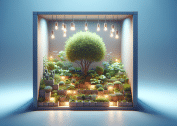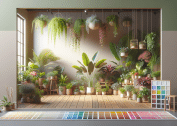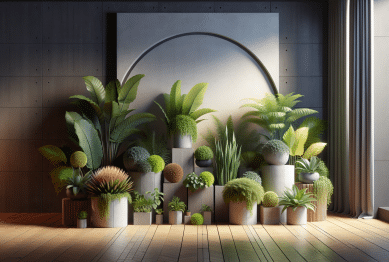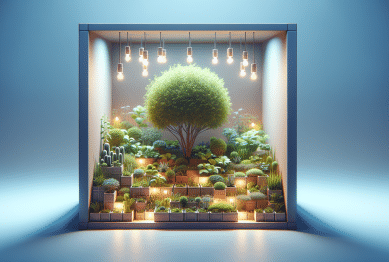Unlock vibrant growth for your indoor greenery by unraveling overlooked secrets in indoor plant care. This guide explores light, soil, watering, pest management, propagation, and how houseplants can truly thrive. Get ready to see your home garden flourish in ways you never expected.
The Essentials of Indoor Lighting for Plants
Lighting is the backbone of healthy indoor gardening. Without the right amount of light, even the hardiest houseplants can struggle to thrive. Many people notice wilting, faded leaves, or stunted growth and wonder why their plant just seems sad. The answer often lies in the balance between natural and artificial light. South-facing windows offer abundant sunlight, while east and west exposures provide softer, indirect rays. If your space lacks these windows, don’t worry: advances in affordable LED grow lights allow nearly any home to maintain a lush, green oasis. Understanding how much light your plant species truly needs is a crucial step, so check care labels or use a mobile light meter for exact placement. This careful attention supports robust foliage, vibrant blooms, and robust root systems (Source: https://extension.psu.edu/indoor-plant-light-requirements).
Sometimes, it’s not just the intensity but the duration of light that matters. Some houseplants—like African violets and snake plants—need twelve to sixteen hours of light per day to really thrive indoors. If the days are short or the sun is unreliable, artificial lighting can supplement what’s missing. On the other hand, too much direct sun risks leaf burns or dehydration, so be ready to rotate or move your pots as the seasons change. Observing leaf color and how quickly the soil dries gives hints for tweaking conditions. Setting up adjustable timers for grow lights is an easy way to keep routines consistent, even on busy days. Watch for subtle changes in your plants—they are telling you what they need (Source: https://www.rhs.org.uk/advice/profile?PID=524).
Light quality also matters. Not all bulbs are created equal. Full-spectrum bulbs approximate sunlight and benefit almost any greenery. Meanwhile, fluorescent lights are energy-efficient options for small plant shelves or desktops. LEDs are popular because they run cool and deliver targeted wavelengths for photosynthesis, reducing wasted energy. Experimenting with light heights or color temperatures can make a dramatic difference for picky growers such as orchids or bonsai trees. If you notice leggy growth or paler young leaves, it’s a clue to reevaluate your lighting strategy. Little tweaks, like using reflective surfaces or white walls, can help bounce more light around your plant-filled corner for extra energy gain.
The Role of Soil and Moisture Balance
What’s beneath the surface makes all the difference in successful indoor gardening. The right soil composition supports air flow, moisture retention, and root nourishment. Popular myths often say any potting mix will do, but plant health experts advise selecting blends tailored for specific plant families. For example, succulents demand a quick-draining, sandy mix to prevent root rot, while ferns and tropicals do better with loamy, moisture-holding soils (Source: https://hgic.clemson.edu/factsheet/growing-indoor-plants-with-success/). Mixing perlite, coconut coir, or compost gives roots the air and nutrients required for lush growth. Elevated or self-watering pots can further improve moisture balance.
Watering causes confusion for many plant enthusiasts. Every species has its own hydration rhythm. While snake plants like to dry out between soakings, peace lilies want steady moisture. A simple finger test—insert your finger two inches deep to check for dampness—prevents overwatering. If the soil clings to your finger, the plant is hydrated. If not, it’s time for a drink. Self-watering planters or moisture meters are affordable tools that take the guesswork out and protect against accidental floods or droughts. Don’t forget humidity: some exotics need misting or tray pebbles to thrive. Keeping a close eye on your indoor microclimate can turn average results into real indoor gardening triumphs (Source: https://www.gardeningknowhow.com/houseplants/hpgen/houseplant-watering-tips.htm).
Layering is another secret weapon. Placing a layer of gravel or broken pottery at the pot’s base boosts drainage and keeps roots out of standing water. This simple technique prevents soggy soil and root rot—a silent plant killer. Choosing the right container size matters too. Too large, and soil stays soggy. Too small, and roots crowd, stunting growth. Repot every year or two to refresh soil nutrients and allow room for robust spread. Keeping a routine for soil health, water checks, and gentle root disturbance can boost both plant beauty and resilience long-term.
Mastering the Art of Proper Watering
Improper watering habits are the number one reason houseplants fail. Overwatering causes yellow leaves and mushy stems, while underwatering leads to dry edges and wilting. Recognizing signs and adjusting habits makes a world of difference in plant health. Start by reading the specific needs on plant identification tags or referencing reputable online care guides. Some plants prefer a bottom-up soak, where water is absorbed through drainage holes, reducing the risk of surface fungus. Others thrive with light topwatering that moistens their shallow roots first. Adjusting to the seasons—watering less in winter and more as growth resumes in spring—helps mimic natural patterns for better results (Source: https://web.extension.illinois.edu/houseplants/watering.cfm).
Humidity and air flow also influence how much water indoor plants really need. Central heating or air conditioning dries the air quickly, stealing precious moisture. Regularly monitor environmental conditions, and remember, even two identical plants can have different needs depending on their placement within your home. Try grouping similar plants together for shared humidity, or add a small humidifier for finicky species. It’s about understanding patterns, not memorizing rigid rules. When leaves start to look less glossy or edges brown, tweak watering, misting, or airflow slightly. Small, regular observations help create a feedback loop that keeps plants happy.
Fertilization is the finishing touch to a good watering routine. Over-feeding can kill houseplants as fast as neglect, so always follow label instructions carefully and dilute liquid fertilizers as needed. Most plants need a gentle feeding every four to six weeks during active growth periods, with less or none through winter. Choosing formulas made for houseplants supports balanced nutrition and strong roots. Look for slow-release pellets or organic options for a steady supply of nutrients. Clean any salt buildup on pot rims, which signals too much fertilizer or minerals. Thoughtful nutrition and watering combine to unlock that lush, vigorous look every plant lover desires.
Preventing and Treating Indoor Plant Pests
Pests can sneak indoors and damage houseplants before you spot the culprits. Common issues include spider mites, scale insects, and fungus gnats. These pests drain sap, chew leaves, or attack roots from the soil upward. A regular inspection routine—looking under leaves, in stem crevices, and at soil surfaces—catches problems early. Sticky residue on leaves, webbing, or sudden discoloration are all potential warning signs. Quarantine new arrivals for a week or two to prevent spreading hidden pests to healthy plants (Source: https://ucanr.edu/sites/Houseplants/files/282998.pdf).
Natural treatments make pest control possible without harsh chemicals. A gentle wash with soapy water removes aphids or scale, while neem oil is popular for ongoing prevention. Sticky yellow traps, available in garden stores, catch flying invaders before they multiply. Proper airflow, careful watering, and avoiding overcrowding also reduce the risk of pest infestations. Bringing houseplants outdoors for occasional fresh air and sun can help naturally suppress bugs. Always monitor closely for changes in the days following any treatment. For stubborn infestations, targeted biological controls such as predatory insects may help restore balance without harming other plants.
Self-care for your indoor garden includes ongoing vigilance. Early action saves most plants, while delayed intervention risks leaf loss or spreading infestations. Wash tools and hands well between plants, just like a surgeon prepping for procedures. Swap out top soil, repot infested plants, and dispose of heavily damaged specimens responsibly. Keep a journal of any issues and what worked or didn’t. This record becomes a helpful troubleshooting guide for future problems. With consistent observation and gentle intervention, your indoor oasis stays healthy, colorful, and pest-free year-round.
Easy Propagation for a Bigger Urban Jungle
Propagation allows you to multiply favorite plants from a single specimen, creating a lush home garden without continuous shopping. Techniques include stem cuttings, leaf cuttings, division, and even water propagation for certain easy-care species such as pothos, spider plants, and philodendrons. Using sterilized tools is the first step for success. Simply snip a healthy stem, remove lower leaves, and place it in water or a small pot with fresh soil. Covering the cut in rooting hormone increases the chance of vigorous root growth. Place your new plantlet in bright, indirect light and keep it moist—not soggy—for several weeks. Patience pays off (Source: https://extension.umn.edu/houseplants/propagating-indoor-plants).
Layering and division work for bushier or clumping plants. For example, dividing a peace lily’s root ball at repotting time results in two thriving plants instead of one. String-of-pearls or wandering jew (Tradescantia) easily root wherever their nodes touch moist soil, offering almost effortless multiplication. The key is to ensure any separated piece includes both root and stem tissue to support independent growth. New baby plants may droop initially but tend to perk up given gentle care. Successful propagation brings a sense of accomplishment—plus affordable gifts for fellow plant lovers or ways to fill empty windowsills.
Document each attempt to identify which methods work best for different species. Some indoor gardeners develop a knack for propagating rare or specialty plants and even swap cuttings within online communities. Tracking conditions such as ambient temperature, humidity, and time to root helps perfect your technique over time. Those who propagate regularly quickly transform an ordinary apartment into a true indoor jungle. Experiment with different containers and environments to learn what your indoor collection really loves.
The Subtle Benefits of Indoor Plant Companions
Beyond their visual charm, houseplants offer meaningful contributions to home health and wellbeing. Research shows that greenery indoors can purify air by removing toxins such as formaldehyde and benzene, leading to fresher breathing spaces (Source: https://www.nasa.gov/sites/default/files/atoms/files/insidethespaceplants.pdf). Large-leafed plants and climbing vines excel at this natural filtration. Even small collections can boost mood, improve focus, and reduce stress, making homes more relaxing and productive places. Incorporating calming plants like lavender or jasmine next to a reading nook brings subtle aromatherapy benefits as well.
Houseplants encourage daily mindfulness and patience. Simple acts of watering or pruning provide a break from screens and structured routines. Children can learn responsibility and observation by tending to their own small pots, while adults find that greenery sparks creativity and curiosity. For those living in apartments or urban dwellings, potted trees and vertical plant walls offer a unique way to feel more connected with nature. Benefits extend beyond the aesthetic—the presence of indoor plants can also contribute to better sleep and a sense of satisfaction from nurturing life within the home.
Arranging houseplants in pleasing groups supports their health and adds drama to indoor decor. Grouping by similar water and light needs simplifies maintenance. Creating height with tall species in the back and trailing types in front delivers appealing natural displays, even in small spaces. Whether your collection is a single succulent or a sprawling array of tropicals, the joy and benefits of mindful indoor plant care are accessible to all. Learning as you grow is all part of the experience—and the rewards multiply season by season.
References
1. Penn State Extension. (n.d.). Indoor plant light requirements. Retrieved from https://extension.psu.edu/indoor-plant-light-requirements
2. Royal Horticultural Society. (n.d.). Lighting for house plants. Retrieved from https://www.rhs.org.uk/advice/profile?PID=524
3. Clemson Cooperative Extension. (n.d.). Growing indoor plants with success. Retrieved from https://hgic.clemson.edu/factsheet/growing-indoor-plants-with-success/
4. University of Illinois Extension. (n.d.). Houseplant watering. Retrieved from https://web.extension.illinois.edu/houseplants/watering.cfm
5. University of California Agriculture and Natural Resources. (n.d.). Houseplant pest control. Retrieved from https://ucanr.edu/sites/Houseplants/files/282998.pdf
6. NASA. (n.d.). Clean air study. Retrieved from https://www.nasa.gov/sites/default/files/atoms/files/insidethespaceplants.pdf









